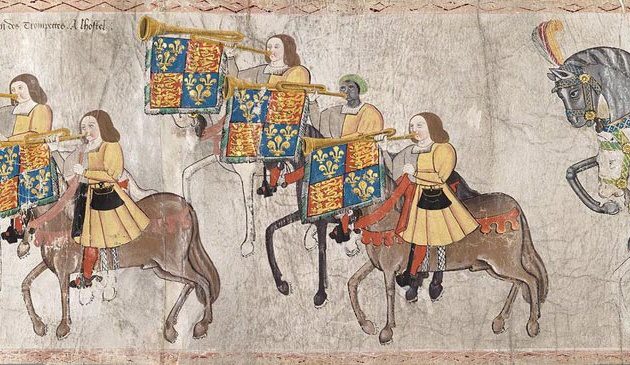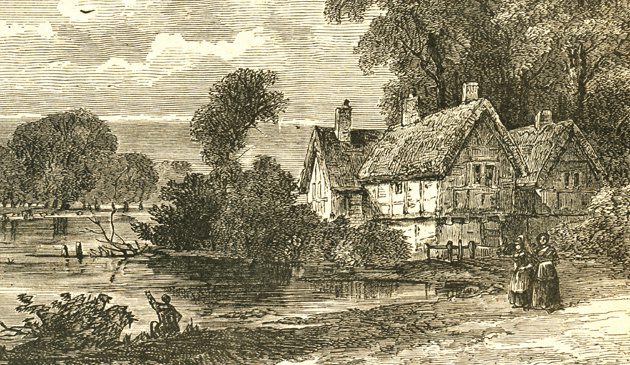In brief – Tudor London

The coronation of Anne Boleyn as Queen of England at Westminster Abbey on Whit Sunday, June 1533. It was the last time a Queen Consort was to have a separate coronation.
The introduction of the process of printing in the late 15th century created a publishing revolution that started to escalate in the 16th century. William Caxton’s assistant, Jan de Wynkyn (more commonly known as Wynkyn de Worde), set up in premises at Fleet Street, starting an association between publishing and printing in that area that lasted until the end of the 20th century. Maps also became popular for those who could afford to buy them to decorate their walls.
In the Tudor period London’s sea trade rapidly increased, particularly the export of English wool and cloth. A group of London businessmen known as the Merchant Adventurers emerged in the 15th century, dominating the booming business in English cloth to Antwerp, and Letters Patent were drawn up in 1505 to bring them together as a single company. A new law of 1558 restricted the loading and unloading of goods in London to a limited number of quays on the north bank of the river in order to simplify the collection of duties. The trading rights of the Hansiatic League of Germanic merchants who had long been a fixture in London were withdrawn and their base at the Steelyard closed in 1598.
Ship-building increased down-river of London, particularly after Henry VIII moved the main base of his navy to Deptford and Woolwich. By the end of the 16th century the area east of London was the largest concentration of ship-building and repairing in the country. Also based at Deptford was the newly-formed Trinity House, a corporation that was given responsibility for safety on the river and continues to operate England’s lighthouses in modern times.
The collapse of the cloth trade to Antwerp in the mid-century forced English merchants to seek new trading routes. Long-distance voyages led to the sharing of risk by merchants and ship-owners with joint-stock companies formed. These merchants met to do business in various places until Thomas Gresham established a building based on the bourses at Venice and Antwerp, it was officially opened by Queen Elizabeth in 1571 and named the Royal Exchange.
In 1577 Francis Drake set out with five ships on a voyage financed by London merchants. His two-year circumnavigation of the globe was only the second-ever attempt and the first by an Englishman. After his return the Queen dined on board Drake’s ship, the Golden Hinde, at Deptford and knighted him. The vessel was dry docked there as a memorial for many years until it disintegrated.
The first purpose-built hospital in the London area was founded by Henry VIII on the site of the former Savoy Palace. The care of the sick by monasteries ended with their dissolution but St. Bartholomew’s and St. Thomas’s re-opened under the management of the City of London, and Bethlehem Hospital for the insane by Bridewell Prison.
London continued to be regularly afflicted by plagues throughout the 16th century. From 1485 until 1551 Britain suffered from an epidemic known as the ‘sweating sickness’ in which thousands of Londoners died. Between 1558 and 1582 plagues arrived in London every four years on average. A contemporary historian reported 20,000 dying in London in 1562. Following the death of Elizabeth in 1603 the coronation of James I was delayed due to a plague.
Almost all food was purchased daily from markets that snaked through many of London’s streets. Most of them had been established during the previous centuries but grew during the Tudor period. St. Bartholomew’s fair at Smithfield had evolved from one selling cloth into the largest general entertainment fair.
After the Duke of Somerset came to power as the protector of Edward VI he set about creating for himself a riverside palace beside the Strand. Somerset Palace was possibly the first in England in the Italian Renaissance style, with gardens stretching down to the river. The Duke’s rise and fall was so swift it is unlikely that the building was completed by the time of his execution in 1552.
The Duke was only one of several famous people who were executed within the Tower or on Tower Hill during the Tudor period. Others included Henry VIII’s wives Anne Boleyn and Catherine Howard, Sir Thomas More, the Bishop of Rochester, Thomas Cromwell, Archbishop Cranmer, Lady Jane Grey, Edward Campion, Sir Walter Raleigh and the Earl of Essex. Famous prisoners of the period included Princess (later Queen) Elizabeth, who was imprisoned for a time by her half-sister Queen Mary.
The early death of Edward VI in 1553 resulted in a power-struggle, with Mary, Edward’s older sister, seizing the throne and the execution at the Tower of her Protestant rival Lady Jane Grey. Mary only lived another five years but during that time the country lurched back to Catholicism. The Pope’s English representative, Reginald Pole, insisted that any religious leader who was not loyal to the pontiff should be tried and executed. The directive was implemented by the Bishop of London, Edmund Bonner, and a number were burnt at the stake outside the city wall at Smithfield.


